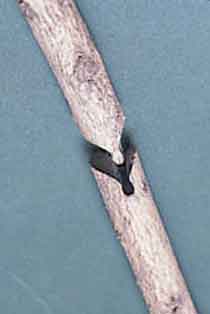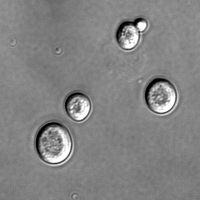German wine glossary
A B C D E F G H I J K L M N O P Q R S T U V W X Y Z
Bacchus
Roman god of wine. Not to be confused (though it often is) with Dionysus, who was the Greek god of wine before the age of Rome.
Bacchus (enable pop-ups to see pictures) for a full list of grapes click HERE
(white grape) This is a cross between a Silvaner × Riesling hybrid with Müller-Thurgau. It is important in the Franconian district (12% of plantings) and on Lake of Constance . Bacchus musts have more sugar than those of Müller-Thurgau but lower acidity. The wines are fruity and have a distinct Muscat bouquet sometimes similar to Scheurebe. Dr Husfeld of Geilweilerhof created it in 1959. There are now 3,200 ha planted. Tends to be low in acidity and so is mainly vinified to be a sweet wine with Muscat-like or occasional delicate Sylvaner flavours because of its ability to reach "Auslese" style or even higher sugar levels in good years. Commonly blended with lesser grape wines in the Rheinhessen region of Germany to create "QBA" type village wines. Its popularity is only exceeded by the Kerner or Ehrenfelser varieties. Not to be confused with a currently rare early 19th century American hybrid that also bears the Bacchus name but is not related in any way to the above variety.
Baden
Baden is the southernmost of Germany 's wine regions. It is primarily a long, slim strip of vineyards nestled between the hills of the Black Forest and the Rhine River ; it extends some 400 km from north to south. It runs parallel with Alsace on the other side of the Rhine . The area is the home to made co-operatives and the flatter land is easier for mechanical harvesting. Comprised of nine districts, Baden has many soil types and grape varieties.For furtherinformation go to Wine from Baden page.
Bacterial
A tasting term often used by wine judges to describe wines with unpleasant, but ill-defined off odours or flavours.
Baking
In wine this term refers to the process of producing "Sherry" by deliberately oxidizing the wine through heating and aerating it for a period of several weeks. It is not uncommon for the process to take place over a 4 to 7 week time period at 135 degrees F (57 degrees C)!
Balance
A subjective term used in wine evaluation. A wine in which the tastes of acid, sugar, tannin, alcohol and flavour are in harmony is said to be "in balance."
Balling
A density scale, named for its developer, used for measuring sugar content in water based solutions. Since grape juice is primarily sugar and water, the balling scale was used for a quick and easy "sugar analysis" of juice. The Balling scale contained a slight inaccuracy however, and this was later corrected by Dr. Brix. Today the Brix scale is in actual use, but the terms Balling and Brix often are used interchangeably. The Balling (Brix) scale is simplicity itself: Each degree on the scale is equivalent to 1 percent of sugar in the juice. For example, grape juice which measures 15.5 degrees on the Balling or Brix scale contains about 15.5% sugar.
Barrel
Modern wine barrels are made of oak staves shaped into bulging cylinders that are bound by steel hoops and capped with flat circular heads at both ends. The belly, or bilge, allows them to be rolled and turned, and when stored horizontally, facilitates racking (the transfer of clear wine to another barrel).
Barrel fermenting
The act of fermenting white grape juice in barrels instead of using the more usual stainless steel tanks. Red wines are never fermented in barrels because of the necessity to ferment red wines in contact with their grape skins. It is virtually impossible to move grape skins in and out of a barrel through the small bung hole.
Barreling down
The act of placing a wine into barrels for aging.
Baume
A system for measuring the sugar content of grape juice by its density. It is not easy to use because the numbers aren't easy to handle
Each degree Baume is equal to approximately 1.75% sugar in the juice.
Literally, "berry selection" in German. Beerenauslese wines are made from grapes that are picked individually rather than as whole bunches. All grapes on a given cluster or "bunch" do not normally ripen at exactly the same rates. Berry selection allows the winemaker to make superb wine by insuring that every grape berry is picked at optimum ripeness.
Bench Graft
A method of grafting grape vines in which the fruitwood cuttin g is notched at the lower end. The rootstock cutting is also notched, but at the upper end and, most importantly, with a notch design which will allow the fruitwood piece to fit into the rootstock piece like two pieces of a jigsaw puzzle. After the two are pressed together in a way which causes the cambium layers to remain in tight contact, the couplet is stored on its side in a warm, moist condition for several weeks until a callous forms around the union, sealing it. Each of these calloused benchgrafts is then "planted" into a milk carton sized container filled with a porous soil substitute. The cartons are held in a warm greenhouse for a few weeks until green growth appears at the upper (fruit variety) end and roots appear in the soil at the rootstock end. Presto, you now have a "rooted benchgraft" ready to be carefully nurtured into a new grapevine, with a Phylloxera-resistant root at the bottom and the fruiting variety you desire on top
g is notched at the lower end. The rootstock cutting is also notched, but at the upper end and, most importantly, with a notch design which will allow the fruitwood piece to fit into the rootstock piece like two pieces of a jigsaw puzzle. After the two are pressed together in a way which causes the cambium layers to remain in tight contact, the couplet is stored on its side in a warm, moist condition for several weeks until a callous forms around the union, sealing it. Each of these calloused benchgrafts is then "planted" into a milk carton sized container filled with a porous soil substitute. The cartons are held in a warm greenhouse for a few weeks until green growth appears at the upper (fruit variety) end and roots appear in the soil at the rootstock end. Presto, you now have a "rooted benchgraft" ready to be carefully nurtured into a new grapevine, with a Phylloxera-resistant root at the bottom and the fruiting variety you desire on top
Bentonite
A clay that can be used as a fining agent.
Bentonite
A clay which, in very pure form, is used to fine wines, especially white wines for the purpose of correcting heat instability. When stirred into a wine, the bentonite absorbs excessive yeast protein from the wine and holds it tightly. Under some conditions, this protein could later cause a cloud, haze or sediment to form in the wine if not removed. After allowing the bentonite to contact the wine, it is racked or filtered off, taking the protein with it and ridding the wine of the future problem. The wine is said to have been "bentonite fined."
Bereich
The German word for "region." Under the German wine laws established in 1971, a Bereich is a district or subregion within an anbaugebiet (quality-wine growing region). There are forty-three Bereiche throughout the thirteen Anbaugebiete. Within a Bereich there are grosslagen (general sites) and einzellagen (individual sites or vineyards).
Bergwein
Term in Austria for wine made on slopes steeper than 26 per cent, most common in the Wachau and Styria. Unlike wine made from flatter land, it may be sold in a regular 75-cl/27-fl oz bottle even without satisfying Qualitatswein requirements.
Bernkaster Doktor
The most famous vineyard on the mosel 3.2 ha
Big
Subjective tasting term which refers to a heavily flavoured, often tannic and alcoholic wine.
Bischöfliches Konvict
A Catholic refrectory for students in trier.a large part of its endowment is vineyard parcels on the Mosel.
Bischöfliches Priesterseminar
Catholic seminary in Trier that owns some excellent parcels of vines ion the Mosel.
Bitterfäule
Disease caused by the fungus Greenia uvicola that spreads in warm, damp weather attacking damaged over ripe tissues and causing a bitter taste in wine. Controlled by fungicides.
Biologische Sãureabbau
Malolactic fermentation.
Biodynamic vitulture
An extension of organic viticulture, taking into account the effect of the moon and planets on the health of the vines. Based on the principles of Austrian philosopher Rudolf Steiner.
Bitter
Subjective tasting term. Bitterness usually refers to tannin in wine and is sensed by taste buds along the sides of the tongue near the extreme back of the tongue.
Black rot
Fungus disease of grape vines.
Black Riesling for a full list of grapes click HERE
(red grape) Alias name for Pinot Meunier. (See below).
Blauburgunder for a full list of grapes click HERE
(red grape) This is a clone of Pinot Noir widely grown in Germany and Austria . Also known as Spatburgunder meaning late Burgundy .
Back to the Top of wine glossary
Blaufrankish
(enable pop-ups to see pictures)
for a full list of grapes click HERE
(red grape) Once thought to be a Gamay type clone variety but now regarded as a separate variety grown in Austria and used to produce dry, fruity red wines. Has synonym name Gamé where grown in Bulgaria . The grape is also grown in Germany under the name Limberger. Also known as the Kékfrankos grape in Hungary and currently the main ingredient partly replacing Kadarka in the red wine blend once famous as "Egri Bikaver". According to a recent database search this variety has over 40 synonym names in countries spread over Eastern/Central Europe .pronunciation
Blau Portugieser for a full list of grapes click HERE
(red grape) (a.k.a Portugieser, see below.)
Blending
Combining two or more wine varieties, wine types or wine lots for the purpose of correcting (or covering up) some deficiency in one of them. Also, to improve the final blend by a harmonious addition of some other wine which can add a desirable feature to the combination. Blended wines are often more complex than similar wines made from a single grape variety.
Bleichert
German term for a rose wine (Bled)
Bloom
The greyish, powdery film which occurs on grapes in the field, and which contains traces of waxes, wild yeasts and dust.
Blue fining
Fining a wine by adding a solution of potassium ferrocyanide, to remove excessive iron or copper from the wine. Because it is possible to create a toxicity if the fining isn't done exactly right, the practice is no longer permitted in the U.S., France, or in most other countries.
Body
A tasting term referring to viscosity, thickness, consistency, or texture. A wine with body often has higher alcohol or sugar content than others.
Bocksbeutel
Flagon shaped bottle in which Franken wines are bottled. (same shape as a mateus rose bottle)
Boden
The German equivalent of the French terroir.
Bonded cellar
A wine cellar or specified portion of a winery in which non-taxpaid wines are stored. After payment of the tax, the wine is no longer "in bond" and must be moved from any bonded cellar or warehouse.
Botrytis cinerea
Fungus which grows on the skins of certain grapes as they ripen on the vine under specific weather conditions. Called "noble rot" because it can turn ordinary grapes into precursors of great dessert wines. See Edelfaule, Pourriture noble.
Bottle sickness
The state of showing unusually odd or poor quality which is sometimes apparent when a newly bottled wine is tasted. Bottle sickness goes away after a few days or weeks and never reappears in that wine. The exact cause for bottle sickness is not known, but it appears to be related to the abrupt changes in oxidation-reduction balance when an oxygen-starved wine in the tank gets bottled (and oxygenated temporarily). After the cork again seals oxygen out, the wine recovers, settles down and the sickness is over. It then tastes as it did in the tank prior to bottling.
Brettanomyces
A fungal infection. The Brettanomyces fungus can originate in the vineyard but some wineries are chronically contaminated, the organism living in oak barrels or even on the wooden structure of the winery itself. As a consequence the wines from this vineyard can bear a Brett profile - farmyardy, horsy, sometimes metallic aromas - year after year.
Brewers' yeast (Saccharomyces cerevisiae)
One of the simplest eukaryotic single-celled organisms, yeast is also economically very important, in brewing and baking. Other economically important fungi include Penicillium notatum, the source of penicillin, and Aspergillus niger, the source of most commercial citric acid. Neurospora crass is another mainstay of genetic research, as it has conveniently ordered meiotic products in its asci.
Bukett
Smell or fragrance in wine which has its origins in the wine production or aging methods (as opposed to originating in the fruit itself).
Bundesweinpramierung - German state wine award.
Buntsandstein
A type of red sandstone.
Bunte Mergel
Heavy clay loam soil.
Bouvier for a full list of grapes click HERE
Native grape grown in Austria . Produces soft, fragrant white sweet wine called "Sturm" that is drunk very young in the manner of Beaujolais neuveau
Brandy
The alcoholic liquid obtained from distillation of wine.
Breathing
Letting a bottle of wine stand for several minutes to several hours after pulling the cork but before serving it. It is believed that wines which exhibit off odors or tastes when first opened may be improved by air exposure prior to serving. Experienced tasters report that very old red wines are often improved by opening the bottle and decanting an hour or so prior to serving, but young wines rarely need air contact before drinking.
Brenner
A fungal disease of vines mostly found in Germany.
Brilliant
Sensory evaluation term to describe a wine which is crystal clear and absolutely free from sediment or cloudiness.
Brix
(pronounced bricks) The unit of measurment for soluble solids (sugar) in ripening grapes. A reading of one degree brix equals one percent sugar in the juice. See Balling.
Bud break
The action of buds swelling and beginning new growth in spring.
Bud
Small swelling on a shoot or cane from which a new shoot develops.
Bulk
Wine sold by the tank from one winery to another and hauled to the purchasing winery by tank truck. Small wineries often sell their excess, sometimes lesser quality, wines to larger wineries which use it in Generic wine blends. These are usually bottled and sold at low, everyday prices.
Bung
Stopper for barrels. Bungs are normally made of hardwood (but softer than the oak used for barrel staves to avoid damaging the bunghole when opening and closing the barrel). Recent wine barrel bungs are made of silicone rubber.
Bunghole
The hole in the side of a wine barrel through which the barrel is filled and emptied.
Bung Stave
The stave in which the bunghole is located. It is always one of the widest wood staves in a wooden barrel.
Wine villages beginning with 
click the village name for a list of its einzellagen (individual vineyards)
click the village name for a list of its einzellagen (individual vineyards)
Back to the Top of wine glossary







